Spaceships? Check. Lots of alien races with individual powers? Check. Deal making? Check. Technology to research? Check. Sci-fi themed battles? Check. Worlds to colonize and conquer? Check. Attractive visuals? Check. Fun? Keep reading to find out.
“Cosmic Encounter” tasks players with colonizing a set number of foreign worlds before their opponents do. While each player will start off with same number of worlds and ships, they will each represent a different alien race that have various game changing powers. Let’s take a look at the components, rules, and gameplay before heading into the review.
Components
The Warp – This central art piece serves a number of functions. It contains a score track so that players can see how many foreign colonies they currently have at a glance by utilizing Player Control Markers. The warp also serves as a place for your ships to go when defeated in battle.
Hyperspace Gate – This triangular piece helps to remind players who is attacking who. The wide end of the hyperspace gate is where the attacking ships are placed, and the pointy end, well…points…at the planet being attacked.
Planets – Each player will have five planets of their color that make up their home system. Players will receive Ships that start off on these worlds.
Alien Sheets – There are quite a number of alien race sheets…fifty to be exact. Each one has its own unique powers. The top of these sheets are color coded to indicate whether they should be used by beginner (green), intermediate (yellow), and expert (red) players.
Destiny Cards – Players will be drawing these every turn, which indicate who they MUST attack. If the blue player drew a yellow destiny card, then they must attack one of yellow’s planets.
Cosmic Cards – These cards make up a player’s hand. Cosmic cards can be used for attack/defense/surrender (encounter cards), to call in reinforcements (reinforcement cards), and to perform various actions (artifact cards).
Flare Cards – They have the same back as the cosmic cards and allow players to perform special abilities, somewhat like an artifact card. Flare cards name one of the fifty alien races at the top of the card. They have both a wild power at the top of the card and a super power at the bottom of the card. If a player happens to be controlling the race of the flare card drawn, they will be allowed to use the super power listed on the card.
Tech Cards – Tech cards make up a variant and can either be included or excluded from the game. They allow players to research new abilities so that they can perform special actions, among other things.
There are special tokens included in the box that are used during particular circumstances. For review purposes, I’ll opt to skip them. I’ll also be skimming the rules a bit, but if you are interested in learning more, you can check out the manual located here: Cosmic Encounter Manual.
Setup & Gameplay
Setting up the game is fairly simple. Players receive their five planets and twenty ships, placing said ships evenly on the planets. They will need to remove the player colors that aren’t involved in the game from the destiny deck.
Deal two flare cards to each player, have them pick one, and then shuffle both flare cards into the main cosmic deck. Players receive the race sheet of the race listed on the flare card they chose. I highly recommend using only the green colored coded race sheets / flare cards if this is your first time playing. Some of the races that are color coded yellow, and especially red, have some pretty game breaking abilities.
Each player gets eight cosmic cards to start with.
The turns are fairly simple as well and can be laid out as follows:
1. Regroup – You get to take a ship back from the warp, if you have one there.
2. Destiny – Draw from the destiny deck. It will tell you which player you must attack.
3. Launch – Point the hyperspace gate at the planet you are attacking. The attacking player can choose to attack with up to four ships, taking them from any of their planets.
4. Alliance – Both the attacker and defender can ask for help from other players. Those who ally with the attacker and succeed get to place their ships along with the attacker’s on the defender’s planet, giving them a new colony. Those who ally with the defender and succeed get to draw cards and/or take ships from the warp at a rate of one card/ship per ship used to defend.
5. Planning – The attacker and defender only place an encounter card face down.
6. Reveal – Players reveal their encounter cards and add up their ships and the attack strength on their cards to determine who wins. Players have the option of playing negotiate cards in phase five, which can affect the outcome of this phase in various ways. In general, playing a negotiate card means that you surrender, but you get to collect compensation from the attacker.
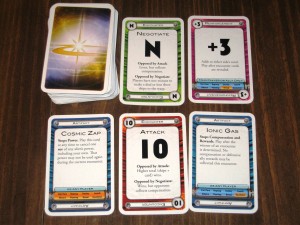
You’re hand will dwindle after a while, so be careful not to get stuck with a bad encounter card at the wrong time.
Players continue in this fashion until they’ve conquered five foreign colonies. There is a bit more to it than that, so please utilize the link to the manual that I provided above in case you want to learn more.
The Review
The first thing I noticed about this game was the art style and the visuals…I don’t have enough thumbs to clearly express how pleased I am by the components. The color schemes are very sharp and the overall feel of the game fits nicely with a sci-fiesque theme.
This game is chaotic, but refreshing all at the same time. I appreciate the functionality of the destiny deck, which prevents bully like behavior and from players being singled out. I played this game with three other kids, all between eleven and sixteen years of age…and you parents out there know how tough it can be to play a competitive game with kids who are constantly seeking to team up against someone else. I felt that the addition of the destiny deck helped to eliminate this tendency well. Sure, the kids could regularly ally themselves with a particular attacker or defender, but their four ships often weren’t enough to turn the tides of battle.
I have to admit that I didn’t play as strategically as I could have, now that I think about it. More often than not, I was out of attack/defense numbered cards and sometimes had two or three negotiate cards in my hand. When the kids saw me only attacking with one ship, they caught on that I was playing a negotiate card. Next time, I think I’ll try attacking with a number card but only use one or two ships, just to keep the kids guessing.
The game has a lot of replayability, seeing as how there are fifty races available. Since each one has its own unique power(s), and since two flare cards are randomly dealt to each player in the beginning, the result is often a combination of aliens that players have never seen before. They might have played the zombie alien before, but have they played it against, say, the anti-matter alien? Each alien you come up against requires a little bit of strategy in terms of how you approach them.
Social interaction is also a big factor, and ends up being a positive one. I say that because players will each be trying to psych the other out in regards to what attack / defense card they are going to play, as well as take into account the allies that may or may not be helping them. To be funny (and it was), the kids’ cousin asked for help defending a planet that I was attacking, to which Vinnie Jr and Anthony Jr came to his aid. He ended up playing a negotiate card, which wiped out his own ships and those of his allies for compensation. We all had a laugh, but needless to say, no one came to his aid again.
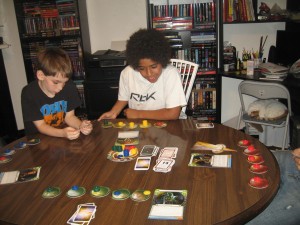
Conversation often revolved around who was using what alien power and what effect it would have on the current board layout.
In regards to a learning curve, I see myself needing a few playthrus to get used to how the rules come together. There’s a possibility that other, new players may have the same experience. Don’t be discouraged…just do your best and have fun. The high replayability factor will help keep the game fresh while you work out the rules and the perfect system. After a few more playthrus, I intend to add the yellow race cards and technology to the game, just to see how that all works out. There are also other variants included in the manual to try out…the short game variant, for example, looks appealing for a number of reasons.
I admit that we didn’t exactly play perfectly our first time through. We were all still learning the rules and getting used to where and when to use our specific alien powers that we often forgot to allow a successful attacker the chance to attack again. When the defender negotiated, we forgot that the loser can pick a card from the attacker’s hand rather than the deck, as we were doing. To be fair, we were playing to have fun, so I just chalked it up to a learning experience and moved on. That’s the beauty of playing games…they are meant to be fun…and rules can be forgotten or adjusted as need be so as long as the play experience is overall positive.
Overall, I highly recommend “Cosmic Encounter.” It’s a game that I’m glad I added to my collection.
Final Verdict: 7/10

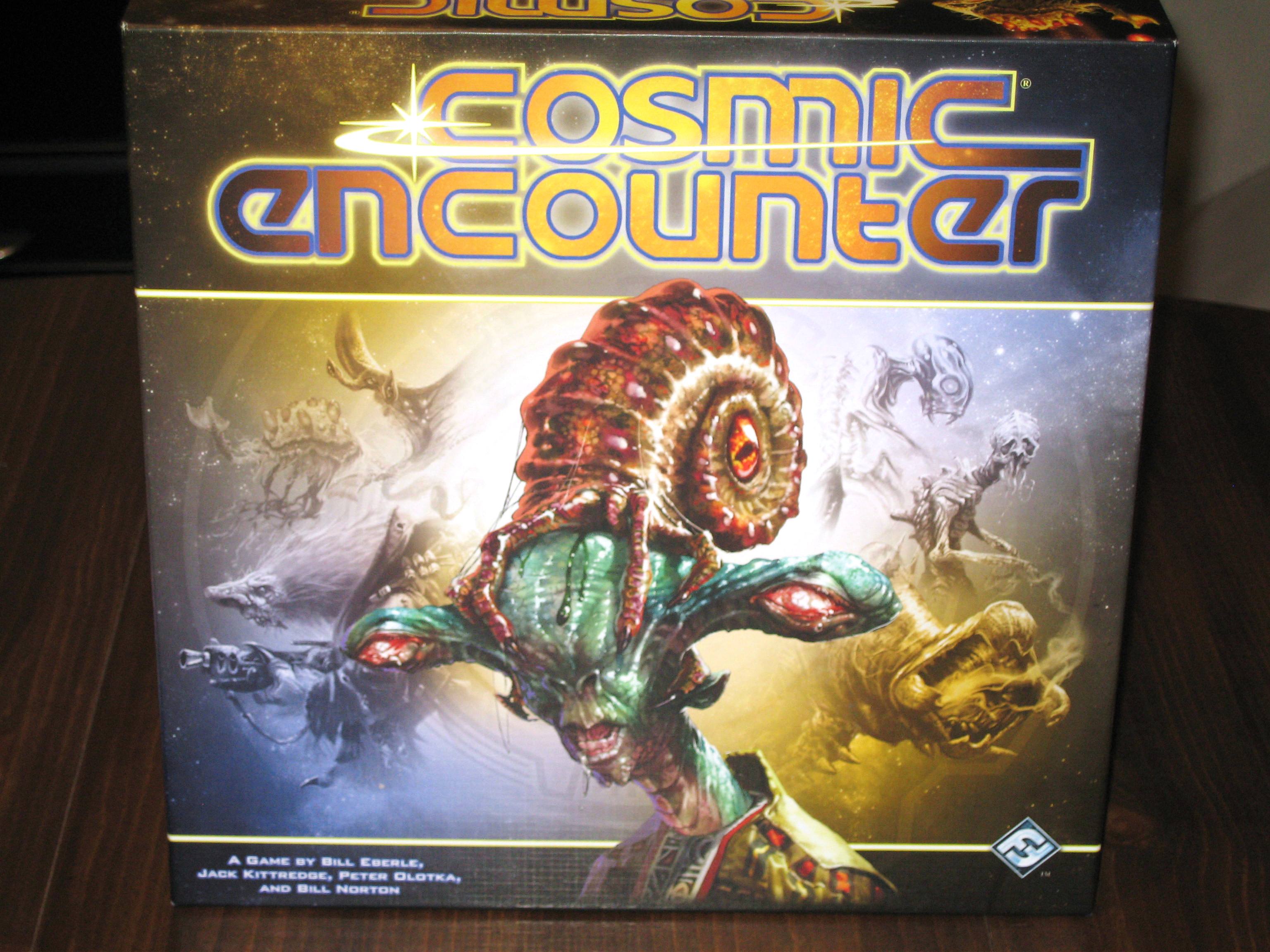
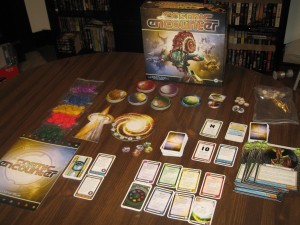
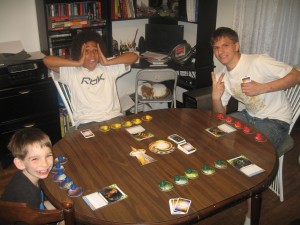
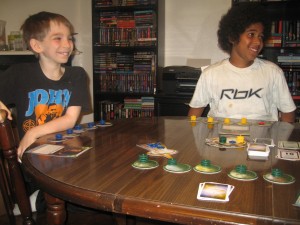
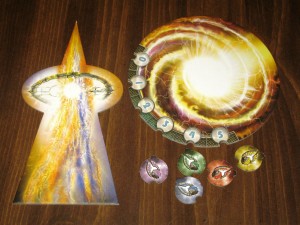
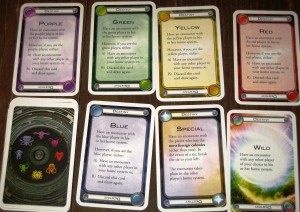
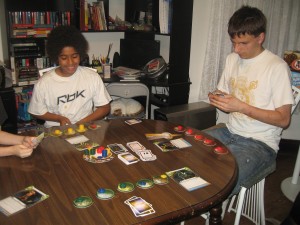
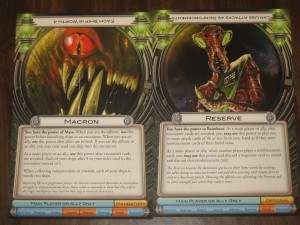
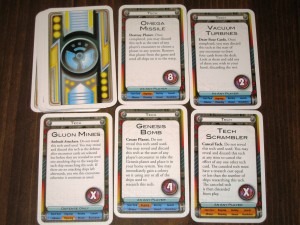
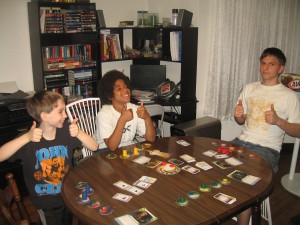
Very nice review! Great pictures and very comprehensive. It might be interesting to see what you think after playing with an expansion set or two. Editorial comment: I always like to read about how a reviewer thinks about the game first and wade through the details of components after. Kind of lead with the meat.
Come join in on the cosmic facebook site where players are designing aliens and other content for a future expansion set.
Thanks.
I thought about writing them that way, but I like to go over components and rules first so that when I reference things in the review, new / interested parties aren’t scratching their heads going, “what is he talking about?” 🙂
Thank you for the kind words, always a pleasure having fellow gamers here!